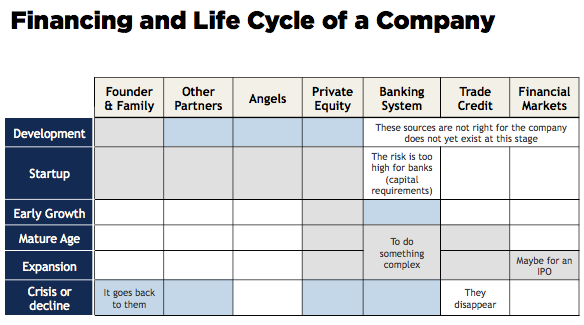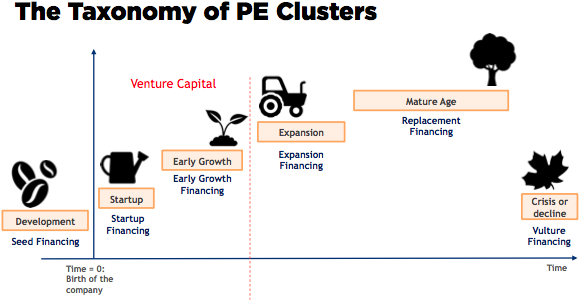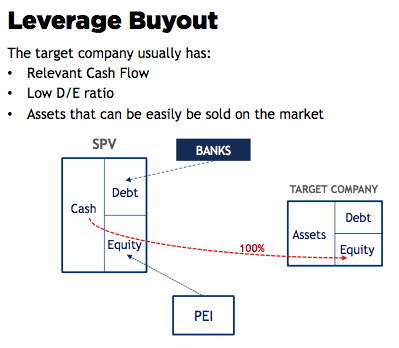What is Private Equity and Venture Capital?
Preliminary Definitions
Two aspects of the Private Equidity (PE):
- PE is a source of financing: It is an alternative to other sources of liquidity, (such as a loan or an initial public offering (IPO)) for the company receiving the financing.
- PE is an investment made by a financial institution: Private Equity Investor (PEI) in the equity of a non-listed company (i.e. not a public company).
Venture Capital (VC) is a very specific case of PE. It is the investment in the very early stages of a company’s life.
The relationship between the PEI and the VBC

The investor gets shares of the equity of the company in return for the inflow of cash.
The Consequences the Financing
- A certain and clearly identified reason;
- The issuance of equity on the private market,
- The newly issued shares will be bought by the PEI;
- The investor: a shareholder + the managers of the company
- Create profit only through the generation of capital gain
The most critical aspect in PE is the strict relationship between the investor and the entrepreneur.
The Difference between: PE and Investing in a Public Company

Why Companies Need PE And VC
PE is based on two aspects:
- A source of financing
- An investment
The venture-backed company wants to enjoy some direct and indirect benefits:
- Certification Benefit
- Network Benefit
- Knowledge Benefit
- Financial Benefit
1. Certification Benefit
This can give a sign of great health of the company and this high quality can be used as a kind of promotion for the venture-backed company’s brand.
2. Network Benefit
The PEI can give the company a very strong network, in terms of suppliers, customers and banks therefore multiplying its possible contacts.
3. Knowledge Benefit
- Soft Knowledge: the capability to manage the business
- Hard Knowledge: the specific-field knowledge of a business "high-tech or pharmaceutical industries"
An advisor and mentor
4. Financial Benefit
Equity ⬆️ →→ Rating ⬆️ →→ Positive effect on the cost of capital

Private Equity Clusters: Through the Fund's Life Cycle
The different kinds of PE investment and the accomplishment of the company

1. Development
Seed financing - develop the business idea
2. Startup
Startup financing -start the business
3. Early Growth
Early growth financing - start its growth
4. Expansinon
Expansion financing - high rate growing
5. Mature Age
Replacement - sales growth is stable
6. Cricis
Vulture financing
The PEI can either be a minority or a majority shareholder:
- Hands-On: Four benefits + operation
- Hands-Off: Four benefits
Seed, Startup, and Early Stage Financing
Seed Financing
The Seed Financing is the most complex and riskiest activity among the PE investment.
Traits:
- An (R&D) project
- Industry-oriented: biomedical, IT, and the pharmaceutical industries / sectors.
- Seed financing - uncertaint
- Trust the idea of the entrepreneur.
- The managerial role of the investor is very limited
Two levels of risk:
- The capability for the idea to generate on output
- If there is an output: does this output have a market ability?
Notes
- 100/10/1 Rule The “psychological threshold” is 1M
- Sudden death Risk
- Size of the Market
Startup Financing
The Startup Financing is the financing of a new company starting its own initial operations.
Traits:
- High risk
- High level of protection for the investor
- Betting on a business plan
- Necessary equipment
Ways of protections:
- Put option
- Collateral - valuable assets + put option
- Stock options - some stock options + profitability of the company
- Balance between money and shares: PE owns 95% of the equity, PEI owns 2% of the equity
Early Stage Financing
Early growth Financing is the financing of the first phase of growth of a new company that has started generating sales.
- Traits:
- Buy inventory + sustain the gap existing between cash flow and money needed
- Negative cash flow
- A very hands-on approach
- The PEI usually has a high amount of shares in the equity of the company
- First 3ys on average after the startup stage
In this kind of investment, the PEI may also not have any protections, due to the high stake in the equity of the company and to the adoption of a hands on approach.
Conclusion on Venture Capital
- A high level of risk
- A hands on approach
- A very deep knowledge of the field
Expansion Financing
The expansion financing takes place in the fastest phase of growth of a firm to consolidate its position in the market. The investment is only used to sustain the (reducing) gap existing between the cash flow and money needed.
Traits:
- sustain the gap (cash flow ◀️▶️ ️ ️money)
- moderate risk
- PE holds not high stake
Types of growth:
- Internal(ororganic)
- External
Internal Growth
- Sustain the procurement of working capital + purchase new assets
- Not difficult for a PEI, the offer is very wide & high number of investors providing the financing
External Growth
The role of the PEI

Two ways of getting the injection of money
- Direct way - the PEI invests in the venture-backed company, from which it gets shares and the company has to get enough money to carry on the M&A
- Indirect way - expensive
- Build a Special Purpose Vehicle (SPV)
- Collect money from the banking system

Replacement Financing
Replacement financing takes place in the mature age of a company and the role of the PEI is that of replacing an existing shareholder.
Traits:
- Face strategic decisions, linked to governance, status, or corporate finance decisions
- Moderate risks, linked to the quality of the strategic process
Three kinds of operations
- Leverage Buyout (LBO)
- Private Investment in Public Equity (PIPE)
- Corporate Governance (CG) Deals
Leverage Buyout (LBO)
LBO is very commonly used, especially in the Anglo-Saxon world, where they account for 45%.

- Relevant Cash Flow
- Low D/E ratio
- Assets that can be easily be sold on the market
Private Investment in Public Equity (PIPE)
- Traits
- Buy a minority stake
- Sell it to anonther potential shareholder
- The profit mechanism is not related to the stock exchange
- To be the biggest sharehloder
- Very aggressive
Corporate Governance (CG) Deals
- Traits
- Manage the redesign of the corporate governance
- Not derive from financial needs of the company.
Vulture Financing
Vulture financing takes place in the final stage of a company’s life cycle, when it enters its decline phase or, worse, a crisis.
Traits
- Sustain the financial gap between the decline of growth
- Lauhch a survival plan
- High risks
- PEI fully understand the field
Two deals
- Restructuring financing (or turnaround)
- Distressed financing
Restructuring financing
The company needs the strategic support from the PEI. For the troubled company, the PEI is
- A financer
- An advisor
- A very strong hands-on approachhe
- A majority stake in the equity of the company
Distressed financing
- Traits
- Not finance the company
- Buy the relevant and valuable assets of the company
- Tough negociation between the court and investor